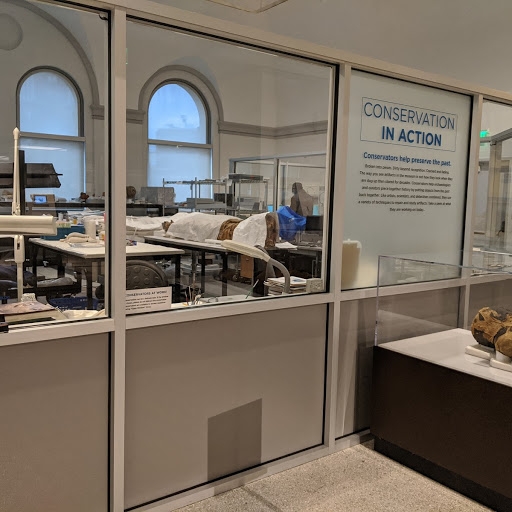At Charles Library we are experiencing a more open office environment. I saw an extreme version at the Penn Museum this weekend ; the conservator’s workspace is actually in the gallery, on view several hours a day. But the office mate, a mummy, is very, very quiet.
These issues of privacy, of noise, and of how we move around our space without disturbing co-workers, surfaced in several workplace norms conversations that I conducted in September. The meetings, organized by work area, were designed to surface issues of concern about the kinds of environment (and behaviors) that would enhance, and detract, from the “ideal” working conditions. Would it be a problem to eat tuna salad at one’s desk? How can we signal to colleagues that we are not “interruptable”?
Some anxiety about establishing workplace norms emerged when we talked one-on-one with staff as part of the Envisioning our Future project. Even before the move, staff were concerned about the more open workplace environment and the need to set guidelines for behaviors. Recognizing as well that multiple types of work would be taking place in our new work spaces. Would this lead to more collaboration in person because of casual interactions, or just more use of electronic communication?
The discussions were summarized and shared with all of the staff in that workspace, including those who were not at the in-person conversations. A summary email was sent to all staff.
Did the workplace norms conversations make a difference? Last week I launched a short survey to staff to gauge the effectiveness of the process. It’s never easy to ask for feedback, risking the possibility that it did not make a difference at all, or worse, it was considered a waste of time. While that didn’t happen, I did learn some lessons, about the process and about assessment.
About 40 staff members participated in the five sessions. 15 of those people responded to the survey. They were from all work areas,
- 66.7% participated in the session
- 86.7% read the document resulting from the session
- 66.7% read the email to staff
I asked three additional questions:
From your perspective, what degree of change has occurred in attending to workplace norms in your area? (0 is “none at all” and 5 “a good bit”)
From your perspective, what degree of change has occurred in attending to workplace norms in your area based on issues discussed in the facilitated conversations/shared documents? (0 is “none at all” and 5 “a good bit”)
Although this is a very small sample, it seems that time in our new spaces has had more of an impact than the actual conversations. (I base this on the fact that the average goes down for the second question). The comments provide a bit more insight into this interpretation:
The process elicited quite a bit of variation between work areas in some aspects of the work environment, like tolerance for noise. Some were disappointed that the outcome did not result in concrete decisions about policy. Others felt that the conversations led to more comfort in discussing the workplace norms. But they were not the real impetus for changes in developing norms that staff are perceiving. Those arise from just just being together. And there are outstanding areas of negotiation, like the use of the breakout rooms.
What did I learn as a facilitator? That I can be challenged by remaining neutral in these situations. I need to follow my own ground rules in providing equal voice to all participants.
But overall, I feel positive about:
- providing an opportunity for staff to get together and
- opening up a dialogue that may not have come about as readily without these meetings
Mainly, I am appreciative of my colleagues who participated in this effort. We don’t necessarily want mummies as our work mates, but it’d be nice to play our music as loud as we like.



